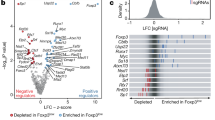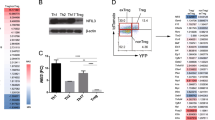Abstract
Foxp3+CD4+CD25+ regulatory T (Treg) cells are essential for the prevention of autoimmunity1,2. Treg cells have an attenuated cytokine response to T-cell receptor stimulation, and can suppress the proliferation and effector function of neighbouring T cells3,4. The forkhead transcription factor Foxp3 (forkhead box P3) is selectively expressed in Treg cells, is required for Treg development and function, and is sufficient to induce a Treg phenotype in conventional CD4+CD25- T cells5,6,7,8. Mutations in Foxp3 cause severe, multi-organ autoimmunity in both human and mouse9,10,11. FOXP3 can cooperate in a DNA-binding complex with NFAT (nuclear factor of activated T cells) to regulate the transcription of several known target genes12. However, the global set of genes regulated directly by Foxp3 is not known and consequently, how this transcription factor controls the gene expression programme for Treg function is not understood. Here we identify Foxp3 target genes and report that many of these are key modulators of T-cell activation and function. Remarkably, the predominant, although not exclusive, effect of Foxp3 occupancy is to suppress the activation of target genes on T-cell stimulation. Foxp3 suppression of its targets appears to be crucial for the normal function of Treg cells, because overactive variants of some target genes are known to be associated with autoimmune disease.
This is a preview of subscription content, access via your institution
Access options
Subscribe to this journal
Receive 51 print issues and online access
$199.00 per year
only $3.90 per issue
Buy this article
- Purchase on Springer Link
- Instant access to full article PDF
Prices may be subject to local taxes which are calculated during checkout




Similar content being viewed by others
References
Sakaguchi, S., Sakaguchi, N., Asano, M., Itoh, M. & Toda, M. Immunologic self-tolerance maintained by activated T cells expressing IL-2 receptor alpha-chains (CD25). Breakdown of a single mechanism of self-tolerance causes various autoimmune diseases. J. Immunol. 155, 1151–1164 (1995)
Baecher-Allan, C. & Hafler, D. A. Human regulatory T cells and their role in autoimmune disease. Immunol. Rev. 212, 203–216 (2006)
Shevach, E. M. CD4+ CD25+ suppressor T cells: more questions than answers. Nature Rev. Immunol. 2, 389–400 (2002)
von Boehmer, H. Mechanisms of suppression by suppressor T cells. Nature Immunol. 6, 338–344 (2005)
Hori, S., Nomura, T. & Sakaguchi, S. Control of regulatory T cell development by the transcription factor Foxp3. Science 299, 1057–1061 (2003)
Fontenot, J. D., Gavin, M. A. & Rudensky, A. Y. Foxp3 programs the development and function of CD4+CD25+ regulatory T cells. Nature Immunol. 4, 330–336 (2003)
Khattri, R. et al. An essential role for Scurfin in CD4+CD25+ T regulatory cells. Nature Immunol. 4, 337–342 (2003)
Fontenot, J. D. et al. Regulatory T cell lineage specification by the forkhead transcription factor foxp3. Immunity 22, 329–341 (2005)
Brunkow, M. E. et al. Disruption of a new forkhead/winged-helix protein, scurfin, results in the fatal lymphoproliferative disorder of the scurfy mouse. Nature Genet. 27, 68–73 (2001)
Bennett, C. L. et al. The immune dysregulation, polyendocrinopathy, enteropathy, X-linked syndrome (IPEX) is caused by mutations of FOXP3. Nature Genet. 27, 20–21 (2001)
Wildin, R. S. et al. X-linked neonatal diabetes mellitus, enteropathy and endocrinopathy syndrome is the human equivalent of mouse scurfy. Nature Genet. 27, 18–20 (2001)
Wu, Y. et al. FOXP3 controls regulatory T cell function through cooperation with NFAT. Cell 126, 375–387 (2006)
Schubert, L. A., Jeffery, E., Zhang, Y., Ramsdell, F. & Ziegler, S. F. Scurfin (FOXP3) acts as a repressor of transcription and regulates T cell activation. J. Biol. Chem. 276, 37672–37679 (2001)
Boyer, L. A. et al. Polycomb complexes repress developmental regulators in murine embryonic stem cells. Nature 441, 349–353 (2006)
Chen, C., Rowell, E. A., Thomas, R. M., Hancock, W. W. & Wells, A. D. Transcriptional regulation by Foxp3 is associated with direct promoter occupancy and modulation of histone acetylation. J. Biol. Chem. 281, 36828–36834 (2006)
Kanehisa, M. & Goto, S. KEGG: kyoto encyclopedia of genes and genomes. Nucleic Acids Res. 28, 27–30 (2000)
Cobb, B. S. et al. A role for Dicer in immune regulation. J. Exp. Med. 203, 2519–2527 (2006)
McHugh, R. S. et al. CD4+CD25+ immunoregulatory T cells: gene expression analysis reveals a functional role for the glucocorticoid-induced TNF receptor. Immunity 16, 311–323 (2002)
Bruder, D. et al. Neuropilin-1: a surface marker of regulatory T cells. Eur. J. Immunol. 34, 623–630 (2004)
Iellem, A. et al. Unique chemotactic response profile and specific expression of chemokine receptors CCR4 and CCR8 by CD4+CD25+ regulatory T cells. J. Exp. Med. 194, 847–853 (2001)
Harbison, C. T. et al. Transcriptional regulatory code of a eukaryotic genome. Nature 431, 99–104 (2004)
Klein, L., Khazaie, K. & von Boehmer, H. In vivo dynamics of antigen-specific regulatory T cells not predicted from behavior in vitro. Proc. Natl Acad. Sci. USA 100, 8886–8892 (2003)
Jordan, M. S. et al. Thymic selection of CD4+CD25+ regulatory T cells induced by an agonist self-peptide. Nature Immunol. 2, 301–306 (2001)
Kretschmer, K. et al. Inducing and expanding regulatory T cell populations by foreign antigen. Nature Immunol. 6, 1219–1227 (2005)
Stanford, W. L. et al. Altered proliferative response by T lymphocytes of Ly-6A (Sca-1) null mice. J. Exp. Med. 186, 705–717 (1997)
Myers, L. M. & Vella, A. T. Interfacing T-cell effector and regulatory function through CD137 (4–1BB) co-stimulation. Trends Immunol. 26, 440–446 (2005)
Bottini, N. et al. A functional variant of lymphoid tyrosine phosphatase is associated with type I diabetes. Nature Genet. 36, 337–338 (2004)
Wu, J. et al. Identification of substrates of human protein-tyrosine phosphatase PTPN22. J. Biol. Chem. 281, 11002–11010 (2006)
Bottini, N., Vang, T., Cucca, F. & Mustelin, T. Role of PTPN22 in type 1 diabetes and other autoimmune diseases. Semin. Immunol. 18, 207–213 (2006)
Vang, T. et al. Autoimmune-associated lymphoid tyrosine phosphatase is a gain-of-function variant. Nature Genet. 37, 1317–1319 (2005)
Acknowledgements
We thank members of the Young, von Boehmer and Fraenkel laboratories, as well as R. Jaenisch and D. K. Gifford, for discussions and critical review of the manuscript, especially T. I. Lee, J. Zeitlinger and D. T. Odom. We also thank Biology and Research Computing (BaRC), especially T. Dicesare for graphic assistance, as well as E. Herbolsheimer for computational and technical support. K.K. was supported in part by a fellowship grant from the German Research Foundation. This work was supported in part by a donation from E. Radutzky, and by the Whitaker Foundation (E.F.) and the NIH (H.v.B. and R.A.Y.). All microarray data from this study are available from ArrayExpress at the EBI under the accession code E-TABM-154
Author Contributions R.A.Y. and H.v.B. contributed both as senior and corresponding authors.
Author information
Authors and Affiliations
Corresponding authors
Ethics declarations
Competing interests
Competing interests: R.A.Y. is a consultant to Agilent Technologies.
Supplementary information
TITLE
This file contains the Supplementary Methods, Supplementary Discussion, Supplementary Notes, Supplementary Figures S1–S6 with legends and additional references. (PDF 2123 kb)
Supplementary Table 1
This file contains Supplementary Table S1 which shows Foxp3 bound regions in stimulated and unstimulated hybridoma cells. The genomic regions that are bound by Foxp3, which are identified at false discovery rates of 5% and 10% in stimulated and unstimulated hybridoma cells, are listed. (XLS 182 kb)
Supplementary Table 2
This file contains Supplementary Table S2 which shows Foxp3 bound genes in stimulated and unstimulated hybridoma cells. Genes with Foxp3 bound regions within a 10kb window (8kb upstream to 2kb downstream) from a well-annotated TSS in stimulated and unstimulated hybridoma cells are listed. (XLS 273 kb)
Supplementary Table 3
This file contains Supplementary Table S3 which shows selected Foxp3 target genes with roles in T cell biology. Many Foxp3 target genes known to play roles in T cell biology are listed and categorized, including miRNAs that are differentially expressed between Treg cells and conventional T cells. (DOC 67 kb)
Supplementary Table 4
This file contains Supplementary Table S4 which shows E2F4 bound regions and genes in unstimulated hybridoma cells. The genomic regions that are bound by E2F4, which are identified at a false discovery rate of 5% in unstimulated hybridoma cells, are listed. The genes with E2F4 bound regions within a 1kb window (800bp upstream to 200bp downstream) around a well-annotated TSS in unstimulated hybridoma cells are listed. This data was generated on the single slide promoter proximal arrays. (XLS 70 kb)
Supplementary Table 5
This file contains Supplementary Table S5 which shows DNA motif results. The log2-odds ratio PSSM of the DNA motif that was discovered by the THEME algorithm within Foxp3 bound regions is provided. The counts of total and conserved Foxp3 and Nfat DNA motifs in Foxp3 bound regions compared to all arrayed regions are provided, as is information about the enrichment of neighbouring forkhead and Nfat motifs in Foxp3 bound regions. (XLS 10 kb)
Supplementary Table 6
This file contains Supplementary Table S6 which shows hybridoma expression dataset. The complete expression dataset from the hybridoma cells is provided in quantile normalized and unnormalized forms. (XLS 10961 kb)
Supplementary Table 7
This file contains Supplementary Table S7 which shows Foxp3 dependant differentially expressed genes in stimulated hybridoma cells. In part (a) expression data for the genes that were determined to be differentially expressed between stimulated Foxp3- and Foxp3+ hybridoma cells are provided. These genes were selected according to methods described in the supplementary section, Identification of Differentially Expressed Genes. This data is displayed in Figure 3a. In part (b) expression data for the probesets that were determined to be differentially expressed between stimulated Foxp3- and Foxp3+ hybridoma cells are provided. (XLS 101 kb)
Supplementary Table 8
This file contains Supplementary Table S8 which shows Foxp3 dependant differentially expressed genes in unstimulated hybridoma cells. In part (a) Expression data for the genes that were determined to be differentially expressed between unstimulated Foxp3- and Foxp3+ hybridoma cells are provided. These genes were selected according to methods described in the supplementary section, Identification of Differentially Expressed Genes. In part (b) expression data for the probesets that were determined to be differentially expressed between unstimulated Foxp3- and Foxp3+ hybridoma cells are provided. (XLS 41 kb)
Supplementary Table 9
This file contains Supplementary Table S9 which shows Ex vivo expression dataset. The complete expression dataset from the ex vivo cells is provided in quantile normalized and unnormalized forms. (XLS 10949 kb)
Supplementary Table 10
This file contains Supplementary Table S10 which shows genes with consistent Foxp3 dependant differential expression in ex vivo and hybridoma cells. Expression data for the genes with the greatest Foxp3 dependent expression in both ex vivo and hybridoma cells are provided. These genes were selected according to methods described in the supplementary section, Identification of Differentially Expressed Genes. (XLS 67 kb)
Supplementary Table 11
This file contains SupplementaryTable S11 which shows eal-time RT-PCR dataset. The complete dataset from quantitative PCR experiments is provided. (XLS 31 kb)
Rights and permissions
About this article
Cite this article
Marson, A., Kretschmer, K., Frampton, G. et al. Foxp3 occupancy and regulation of key target genes during T-cell stimulation. Nature 445, 931–935 (2007). https://doi.org/10.1038/nature05478
Received:
Accepted:
Published:
Issue Date:
DOI: https://doi.org/10.1038/nature05478
This article is cited by
-
Research progress of engineered mesenchymal stem cells and their derived exosomes and their application in autoimmune/inflammatory diseases
Stem Cell Research & Therapy (2023)
-
Evaluation of the relationship between mesenchymal stem cells and immune system in vitro conditions
Molecular Biology Reports (2023)
-
Decreased DIO3OS Expression Predicts Poor Prognosis in Hepatocellular Carcinoma and is Associated with Immune Infiltration
Biochemical Genetics (2023)
-
NF-κB in control of regulatory T cell development, identity, and function
Journal of Molecular Medicine (2022)
-
The effects of vitamin D3 supplementation on TGF-β and IL-17 serum levels in migraineurs: post hoc analysis of a randomized clinical trial
Journal of Pharmaceutical Health Care and Sciences (2021)
Comments
By submitting a comment you agree to abide by our Terms and Community Guidelines. If you find something abusive or that does not comply with our terms or guidelines please flag it as inappropriate.



